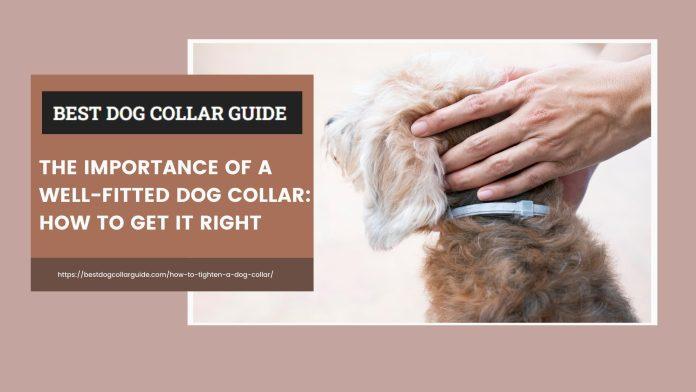Introduction
Your canine companion’s collar serves as more than just a fashion statement; it’s a vital tool for their safety and identification. However, improperly fitted collars can cause discomfort and even pose a risk to your furry friend’s well-being. To ensure your pup stays happy and safe, it’s essential to learn the correct way to tighten their collar comfortably. In this, we’ll explore the steps on How to Tighten a Dog Collar to achieve a snug yet gentle fit, promoting your dog’s comfort and security.
Step 1: Choose the Right Collar
Before we dive into How to Tighten a Dog Collar process, make sure you have the appropriate collar for your dog. Collars come in various materials, sizes, and designs, so selecting the right one is crucial. Nylon and leather are popular choices, as they are durable and comfortable. Additionally, opt for a collar that features an adjustable buckle, as this will allow you to customize the fit precisely.
Step 2: Measure Your Dog’s Neck
To achieve a comfortable fit, accurately measure your dog’s neck circumference using a soft measuring tape. Place the tape around the base of their neck, where the collar will rest. Ensure the tape is snug but not too tight. Record the measurement in inches or centimeters, depending on your collar’s sizing chart.
Step 3: Leave Some Breathing Room
Once you have the measurement, it’s time to adjust the collar. Remember, you want it snug, but not too tight. Allow enough space for two fingers to fit between the collar and your dog’s neck. This will prevent the collar from cutting into their skin or causing discomfort, while still ensuring it doesn’t slip off unexpectedly.
Step 4: Check for Comfort
After securing the collar, observe your pup’s behavior. A comfortable collar will not cause any rubbing, chafing, or signs of irritation. Keep an eye out for any redness or hair loss around the neck area, as this could indicate an ill-fitting collar. If you notice any discomfort, immediately readjust or consider getting a different size or style of collar.
Step 5: Regular Inspections
Your dog’s collar isn’t a one-time setup; it requires periodic checks to ensure an optimal fit. Regularly inspect the collar for signs of wear and tear, as well as any changes in your dog’s size. Puppies grow quickly, and adult dogs can gain or lose weight, so adjustments may be necessary over time.
Step 6: Alternatives to Traditional Collars
If you find that traditional collars still cause discomfort for your dog despite careful adjustments, consider exploring alternative options. Harnesses are an excellent choice for dogs prone to tracheal issues or those who tend to pull on walks. Martingale collars are another safe alternative for dogs that may try to slip out of a standard collar.
Conclusion
Ensuring How to Tighten a Dog Collar is comfortably tightened is an essential aspect of responsible pet ownership. A well-fitted collar enhances your pup’s safety and allows for proper identification, which is crucial in case they ever get lost. Remember to choose the right collar, measure correctly, and always leave some breathing room. Your furry friend will thank you for providing them with a comfortable and secure accessory that allows them to enjoy their walks and playtime to the fullest!
